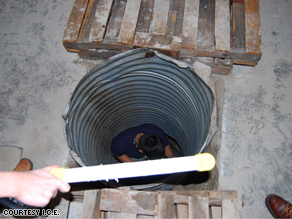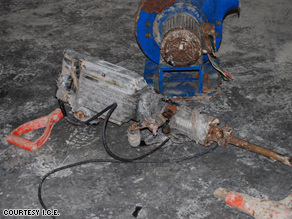Editor's Note: Authorities have uncovered an underground tunnel between Tijuana, Mexico and San Diego, California. Anderson will be live from this new tunnel tonight at 10 p.m. ET.

Charlie Moore
AC360° Senior Broadcast Producer
Authorities have uncovered an unfinished tunnel under the border between the United States and Mexico. The tunnel, complete with an elevator, electricity and a ventilation system, extends from Tijuana, Mexico to Otay Mesa, Calif., in San Diego.
The tunnel was discovered by Mexican law enforcement working with the San Diego Tunnel Task Force, which includes agents from Immigration and Customs Enforcement, the Drug Enforcement Agency and the U.S. Border Patrol.
The tunnel would have been used primarily, if not exclusively, for moving drugs under the border, according to DEA agents. Thirteen people were arrested inside the tunnel last week and an investigation into others responsible for planning and building the illegal tunnel is ongoing.

The tunnel is approximately 900 feet long and reaches a depth of up to 100 feet. Law enforcement agents estimate it has been under construction for roughly three years. The Otey Mesa exit point had yet to be finished, but agents say it was very close to completion.
Over the past year, Mexican and U.S. authorities have ramped up efforts to contain cross-border drug trafficking. This discovery is the latest in a series of tunnels found in recent months under the California and Mexico border. Authorities contend the tunnels are used by Mexican organized crime groups to smuggle drugs under the border into the U.S.

The entrance of the tunnel is in a non-descript warehouse in Tijuana, which contains pallets of soda, paper towels and toilet paper.
To access the tunnel, people would step into a bathroom with a thick concrete false floor connected to a hydraulic system that would lower them down approximately eight feet to the first ‘room’ of the tunnel.
This 15-foot-square room is where agents believe the tunnel workers would squeeze together to sleep.
After the first room, a tunnel shaft extends about 15 feet to a small alcove where there is a dummy car attached to a motorized cable. The dummy car is lowered on a crude, wooden track to the main tunnel shaft.
The main shaft is about five-feet by four-feet and is solid rock. Agents discovered jackhammers and crude picks inside which were used to construct the tunnel. Electric cables and light bulbs run along one side of the tunnel, as well as pipes for water.

The intricate and detailed engineering has led agents to believe that the workers had prior experience in construction.
The dirt floor of the tunnel is littered with things the workers left behind - cigarette lighters, shoes, water bottles and pages torn from magazines.
There is no technology to discover these elaborate tunnels, agents rely only on human intelligence to find them.

No comments:
Post a Comment